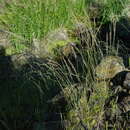mk
имиња во трошки


Poa secunda (variously known by the common names of Sandberg bluegrass,[2][3][4] alkali bluegrass,[4] big bluegrass,[4] Canby's bluegrass,[2] Nevada bluegrass,[4] one-sided bluegrass,[3] Pacific bluegrass,[2] pine bluegrass,[2] slender bluegrass,[2] wild bluegrass,[4] and curly bluegrass[1]) is a widespread species of perennial bunchgrass native to North and South America.[4] It is highly resistant to drought conditions, and provides excellent fodder;[3] and has also been used in controlling soil erosion,[4] and as revegetator,[4] often after forest fires.[6] Cultivars include 'Canbar', 'Service', 'Sherman', and 'Supernova'.[7] Historically, indigenous Americans, such as the Gosiute of Utah, have used P. secunda for food.[8] It was originally described botanically in 1830 by Jan Svatopluk Presl, from a holotype collected from Chile by Thaddäus Haenke in 1790.[2]
Poa secunda (variously known by the common names of Sandberg bluegrass, alkali bluegrass, big bluegrass, Canby's bluegrass, Nevada bluegrass, one-sided bluegrass, Pacific bluegrass, pine bluegrass, slender bluegrass, wild bluegrass, and curly bluegrass) is a widespread species of perennial bunchgrass native to North and South America. It is highly resistant to drought conditions, and provides excellent fodder; and has also been used in controlling soil erosion, and as revegetator, often after forest fires. Cultivars include 'Canbar', 'Service', 'Sherman', and 'Supernova'. Historically, indigenous Americans, such as the Gosiute of Utah, have used P. secunda for food. It was originally described botanically in 1830 by Jan Svatopluk Presl, from a holotype collected from Chile by Thaddäus Haenke in 1790.
Poa secunda es una especie de planta herbácea perteneciente a la familia de las poáceas. Es nativa de Norteamérica.[1]
Plantas azuladas. Perennes, densamente peludas, con brotes estériles intra e extravaginales. Culmos erectos, de 40-120 cm de altura. Vaina de la hoja lisa o escabrida; lígula de 0.5-3 mm, abaxialmente escabrida, truncadas a agudos, de macollos todos truncados. Las inflorescencias en panículas estrechas, densas, de 10-15 × 1-3 cm; ramas fuertemente ascendente, con espiguillas de la base. Espiguillas angostamente lanceoladas, ligeramente comprimidas, 8-10 mm, floretes 4-7; glumas amplia subiguales, la más baja 3-3.5 mm, la superior de 4-4.5 mm. Fl. y fr. Mayo-julio. Tiene un número de cromosomas de 2 n = 62, 63, 64, 65, 68, 70, 71, 97.[2]
Introducida en China, India, Pakistán, SW Asia (Irán), Australia. Es nativa de Norteamérica y Suramérica.
Poa secunda fue descrita por Jan Svatopluk Presl y publicado en Reliquiae Haenkeanae 1(4–5): 271. 1830.[3][4][5]
Poa secunda es una especie de planta herbácea perteneciente a la familia de las poáceas. Es nativa de Norteamérica.